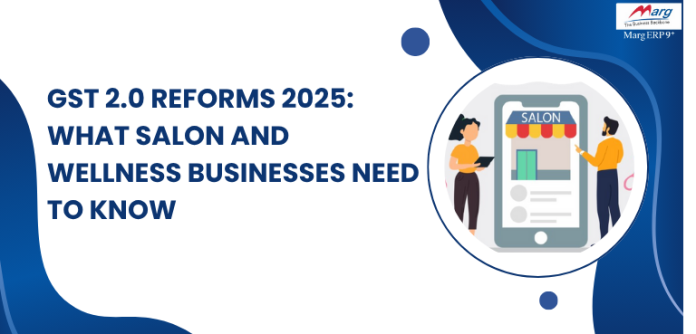The salon and wellness business in India (projected to reach $20 billion) caters to a wide range of services including haircare, skin care, and wellness treatments. This has created a thriving market with a rising demand for grooming professionals. Companies like Urban Company, Naturals, Lakme are bringing salon to home, making the wellness and grooming industry organised and modern.
The sector has seen a welcome change on 3rd September 2025 when FM Nirmala Sitharaman announced GST 2.0 with reduced tax rates and fewer tax slabs. The announcement also mentioned ‘Nil’ tax for some essential items and 40% tax for ‘Sin Goods’ (Tobacco products).
For this passage, we will explore the tax slab which has direct and indirect impact on salon and wellness business in India. Also, we recommend a salon billing software like Marg ERP for easy compliance according to the new tax rates, integrations, and several other exclusive features.
First thing first, let’s begin with understanding the GST 2.0 Reforms 2025.
Understanding the GST 2.0 Reforms (Tax Rates Changes) 2025
In the earlier GST (1st July 2017 onwards) structure, salon and wellness services were taxed at 18% GST with the option to claim Input Tax Credit (ITC) on consumables, equipment, and overheads, a system that helped balance input costs.
With GST 2.0, (Effective from 22nd September 2025) the government has reduced the tax rate to 5%, making wellness and beauty services far more affordable and consumer friendly.
Though ITC is no longer applicable, this simplified tax structure brings greater transparency, easier compliance, and a strong boost to customer demand. For salon owners, it’s an opportunity to rethink pricing strategies, optimize operations, and attract a wider client base while maintaining profitability through smart cost management and efficient use of resources.
Key Impacts on Salons and Wellness Businesses
Lower Costs for Consumers
The most immediate effect of GST 2.0 is that services such as haircuts, facials, massages, and spa treatments become more affordable. This reduction in tax burden makes self-care more accessible, encouraging more frequent visits and broadening the consumer base.
Increased Footfall and Demand
With lower prices, more customers are likely to try services that were previously considered a luxury. This could lead to an increase in overall demand, benefiting both standalone salons and wellness chains.
Loss of Input Tax Credit (ITC)
One of the biggest challenges for salon owners is the elimination of ITC. All taxes paid on consumables, beauty products, equipment, and overheads now become direct costs. This increases operational expenses, requiring careful budgeting and cost management.
Need for Pricing Recalibration
To maintain profitability while passing on some benefits to customers, salons must adjust their pricing models. The goal is to strike a balance between offering savings and retaining sufficient margins to cover input costs.
Industry Growth Potential
The overarching aim of GST 2.0 is to boost consumption in sectors like beauty and wellness. Increased affordability may drive higher spending, more frequent visits, and a healthier economy for the industry.
The Role of Salon Management Software in the GST 2.0 Era
Top salon management software like Marg ERP plays a crucial role in the GST 2.0 times. It’s a win-win situation for salon and wellness business owners and customers. Festive season from Navratri to Christmas is also a grand booster for salon and wellness business. This tax benefits will enhance their business significantly.
- Automate GST calculation and generate accurate invoices
- Single slot GST 2.0 tax rates update
- Track inventory and manage consumables efficiently.
- Analyse service performance, margins, and customer trends
- Simplify GST return filing and compliance
- Manage multi-location large-team operations effectively
Investing in robust salon software ensures businesses remain compliant, reduce errors, and focus on customer satisfaction while adapting to the new tax structure.
Why Marg ERP is the Best Salon Software in India?
Marg ERP stands out as a reliable solution for salon and wellness businesses looking to streamline operations and navigate evolving GST compliances efficiently. It is regarded as one of the best salon software in India, offering a comprehensive suite of features tailored for the beauty and wellness sector.
What are the Key Features of Marg Salon Software?
Comprehensive Billing & Inventory Management: Handle sales, purchases, stock, and multiple locations with ease.
GST Compliance: Simplifies GST billing, return filing, and ensures adherence to non-ITC regulations.
Cloud Accessibility: Access data, reports, and invoices remotely for seamless operations.
Multi-Store & Inventory Management: Ideal for chains or studios with multiple outlets.
User-Friendly Interface: Easy to use, with strong support and training infrastructure.
Customisation Options: Adapt modules for services, memberships, pricing tiers, and packages.
Salons and wellness business can efficiently manage billing, inventory, compliance, and analytics, allowing them to focus on growth and customer satisfaction with Marg Salon Software.
Conclusion
The GST 2.0 reforms present both opportunities and challenges for salons and wellness businesses. Consumers will benefit from lower taxes and more affordable services, while salons must strategically adjust pricing and operational strategies to remain profitable.
Investing in salon billing software or salon management software, such as Marg ERP, is now more important than ever. Not only does it simplify compliance with the new 5% GST regime, but it also enables better cost management, analytics, and customer experience, helping salons thrive in a competitive, evolving market.
With careful planning, pricing strategy, and technology adoption, salon and wellness businesses can successfully navigate GST 2.0, attract more customers, and grow sustainably.




















